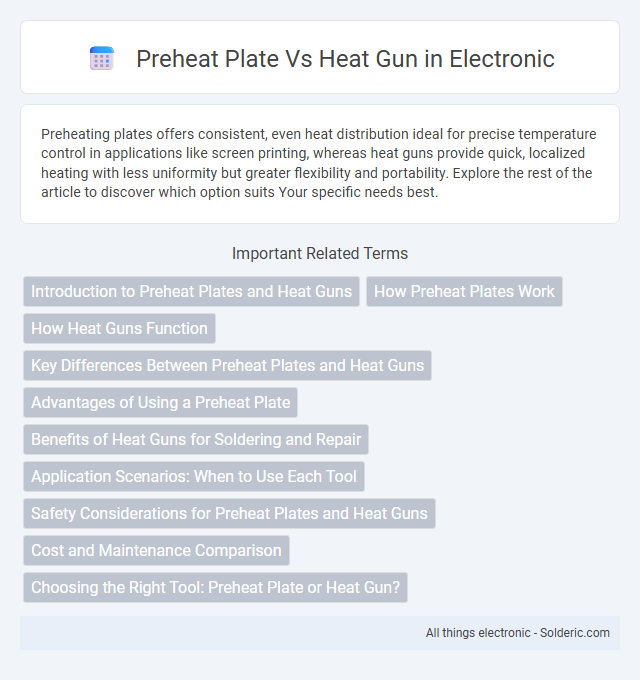Preheating plates offers consistent, even heat distribution ideal for precise temperature control in applications like screen printing, whereas heat guns provide quick, localized heating with less uniformity but greater flexibility and portability. Explore the rest of the article to discover which option suits Your specific needs best.
Comparison Table
| Feature | Preheat Plate | Heat Gun |
|---|---|---|
| Primary Use | Even surface heating, soldering, PCB repair | Targeted spot heating, paint removal, shrink tubing |
| Heat Distribution | Uniform over surface | Concentrated, directional |
| Temperature Range | Typically 100degC to 300degC | Variable, up to 600degC or higher |
| Control Precision | Stable, consistent temperature | Adjustable heat and airflow |
| Portability | Usually stationary | Handheld, mobile |
| Common Applications | Reflow soldering, preheating components | Paint stripping, plastic bending, heat shrinking |
| Safety | Lower burn risk due to surface heating | Higher burn risk, requires caution |
Introduction to Preheat Plates and Heat Guns
Preheat plates and heat guns are essential tools for precise temperature control in soldering, rework, and electronics repair. Preheat plates evenly distribute heat across a surface, reducing thermal stress and improving solder joint quality, while heat guns provide focused, adjustable hot air for targeted heating and component removal. Your choice depends on whether uniform heating or localized heat application is critical for your tasks.
How Preheat Plates Work
Preheat plates evenly distribute heat across a surface, using embedded heating elements to raise the temperature gradually to a precise, controlled level. This steady heat transfer helps reduce thermal shock and improves adhesion in soldering or laminating applications. Your components benefit from consistent warmth, ensuring reliable performance and minimizing damage risks compared to the spot heating of a heat gun.
How Heat Guns Function
Heat guns operate by blowing hot air generated from an electric element through a concentrator nozzle, allowing precise control of temperature and airflow for targeted heating. Unlike a preheat plate, which provides uniform surface heating, a heat gun delivers focused thermal energy to specific components, making it ideal for tasks like soldering, shrink-wrapping, and paint stripping. Your ability to adjust the heat gun's temperature settings ensures efficient heat transfer without damaging sensitive parts.
Key Differences Between Preheat Plates and Heat Guns
Preheat plates provide uniform and controlled heating ideal for consistent temperature maintenance during soldering or rework, while heat guns deliver concentrated, adjustable hot air suitable for targeted heating and removing components. Preheat plates generally offer better temperature stability with precise setpoints, whereas heat guns allow for flexible application angles and rapid temperature changes. The choice between the two depends on the specific task requirements, such as the size of the workpiece and the need for uniform versus directional heat application.
Advantages of Using a Preheat Plate
Using a preheat plate ensures consistent and even heating, which reduces the risk of thermal shock and damage to sensitive components. It provides precise temperature control, enhancing soldering quality and efficiency in electronics repair. Your work benefits from the preheat plate's ability to stabilize the entire board temperature, improving overall reliability.
Benefits of Heat Guns for Soldering and Repair
Heat guns offer precise temperature control and rapid heating, making them ideal for soldering and repair tasks involving sensitive electronic components. Their concentrated airflow reduces the risk of damaging surrounding parts compared to preheat plates, enhancing the quality of your soldering jobs. Using a heat gun improves efficiency and accuracy, ensuring reliable repairs and extended component lifespan.
Application Scenarios: When to Use Each Tool
Preheat plates excel in applications requiring uniform heat distribution, such as reflow soldering of multi-layer PCB assemblies and delicate components to prevent thermal shock. Heat guns are ideal for targeted heating tasks like paint stripping, shrink-wrapping, and localized plastic bending where precise directional heat is necessary. Selecting between the two depends on the need for consistent surface temperature versus focused, adjustable airflow heat.
Safety Considerations for Preheat Plates and Heat Guns
Preheat plates offer consistent and controlled heating, reducing the risk of burns or fire hazards compared to heat guns, which produce intense, concentrated heat that can easily damage components or cause accidental fires. Both tools require proper insulation and supervision, but preheat plates typically have built-in temperature regulation, enhancing safety during prolonged use. Heat guns necessitate careful handling and adequate ventilation to prevent overheating and inhalation of fumes, making personal protective equipment essential.
Cost and Maintenance Comparison
Preheat plates generally offer lower long-term maintenance costs due to their simple design and consistent heat delivery, making them more cost-effective for frequent soldering tasks. Heat guns, while often less expensive upfront, tend to require more frequent replacements and repairs due to their mechanical components and irregular heat distribution. The initial investment in a quality preheat plate can result in reduced operational expenses compared to the variable costs associated with heat gun upkeep.
Choosing the Right Tool: Preheat Plate or Heat Gun?
Choosing the right tool depends on your project's requirements: a preheat plate offers consistent, even heating ideal for larger surfaces or delicate components, while a heat gun provides targeted, adjustable heat for smaller or intricate areas. Your decision should factor in material sensitivity, temperature control, and workspace size to ensure optimal results. Using a preheat plate can reduce thermal stress, whereas a heat gun allows for quick, precise applications where mobility is essential.
Preheat plate vs heat gun Infographic

 solderic.com
solderic.com